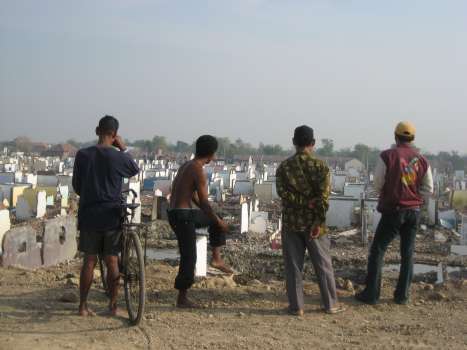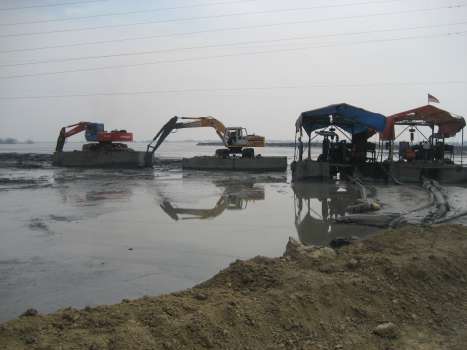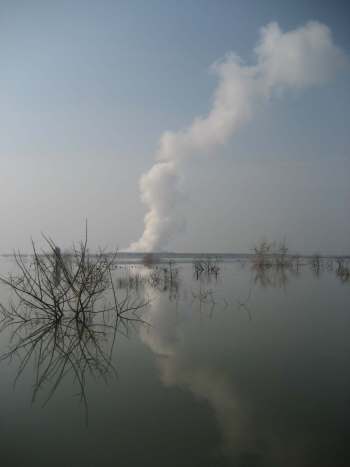An unstoppable flow of mud from an explosion in a gas well in Sidoarjo, East Java, has unleashed a plethora of political issues.
Jim Schiller
Smoke billowing from the centre of the gas well explosion
|
On 28 May 2006, the operators of a well drilling for natural gas in Sidoarjo, 30 kilometres from the centre of Indonesia’s second largest city, Surabaya, reported a ‘blow out’. The explosive outburst of steam and mud—nearly three kilometres below the earth—was not contained and soon hot mud was overflowing from the surface of the well. It started at a rate of about 5000 cubic metres per day. Eighteen months later the estimated daily flow varies from 80,000 to 100,000 cubic metres per day. The mud now covers more than 15 square kilometres. That is enough mud to bury the central business district of a city the size of Adelaide in South Australia to a depth of 13 metres. No one knows when it will stop.
The 80-degree hot, stinking mud has forced more than 50,000 people from Sidoarjo and its surrounds to abandon their homes, rice fields and agricultural land. So far, 12 villages with 10,000 houses and more than a hundred other buildings including factories, schools, shops, and mosques have been abandoned. Many Sidoarjo industries, including its well-known leather handicraft producers, have been devastated. Customers are frightened of travelling near the mud to shop, or to collect their orders.
The mud’s impact reaches far beyond the Sidoarjo area. It caused the explosion of the East Java gas pipeline which is used to provide electricity for major industries. Despite the mobilisation of thousands of villagers to contain it, the mudflow has frequently covered the main toll road and other road and rail links between Surabaya and the cities of Malang and Pasuruan—the gateways to the province’s south and southeastern hinterland. Exporters from these areas, as well as from Bali and the islands beyond, have complained that they cannot reliably transport goods to the port of Surabaya. The Surabaya toll road, a major highway and the rail connection to Malang will all need to be relocated.
The National Planning Board (Bappenas) estimated the disaster damage for the first year of the mudflow was more than US$4.9 billion. That does not include infrastructure costs such as relocating the toll road, gas pipeline and the railway line. No one has persuasively calculated the potential costs of damage to the land, river, coastal, and marine environment. These risks have been increased by the decision to divert the mud to the Porong river and the Java Sea. The mud’s heat and composition are a threat to brackish water ponds and off-shore fisheries, while a growing worry is that the mud which has filled the Porong river and is entering the Brantas will block the rivers and result in severe flooding.
Many of the victims have seen not just their houses, but their entire village disappear.
Thirteen deaths have been directly attributed to the mud. However, the loss of homes, schools, villages, communities and incomes has made many more vulnerable to life-threatening illness. High levels of respiratory illness have been reported among the displaced persons and in those living around the mudflow.
In efforts to save their villages from the mud, residents have built, reinforced, patched and rebuilt more than 30 kilometres of earthen dams—some of them 10-15 metres high. The seemingly never-ending threat from the mud, the repeated failure of their dams, and the slow realisation that they will never return to their villages has led to widespread psychological problems among the victims. Many have seen not just their houses, but their entire villages disappear.
A disastrous response
The scale of the disaster is only part of the reason why the Sidoarjo mudflow has been the centre of national attention for much of the last year. The company drilling the well was PT Lapindo Brantas, part of a conglomerate controlled by Aburizal Bakrie, the Coordinating Minister of People’s Welfare. Bakrie—a former Suharto-connected businessman with an estimated net worth US$500 million who survived his patron’s fall—is also one of Indonesia’s richest men. To many Indonesians, the involvement of such a powerful political and economic player in the disaster goes a long way to explaining what they see as the incompetence of the government’s response, and the inadequacy of its assistance to the victims.
The central government response was not rapid. It took 102 days to create a temporary national team to deal with the mud and the victims (Timnas). During that period PT Lapindo Brantas, a majority stakeholder in the gas well, provided some funding for villagers and the district (kabupaten) government to deal with the mud and assist its victims. It is generally accepted that the Sidoarjo district government lacked the human resources and the authority to coordinate and manage the equipment and the skills needed to respond to a disaster of this magnitude.
Timnas was to be a coordinating agency, using local and national government infrastructure as well as international expertise and resources to mitigate the problem. It consisted mostly of engineers and officials from the Research Section of the Department of Public Works in Bandung, so it should not be surprising that it was mostly concerned with containing the mud.
Lapindo Brantas funding of both the mud containment and humanitarian aid efforts has been the daily focus of Indonesia’s media for more than a year.
Lapindo Brantas retained responsibility for funding the mud control and victim assistance programs. To acquire earth moving equipment, deploy dump-trucks or order construction materials Timnas had to gain approval from Lapindo’s field director. Funds were not always available. Engineers who faced almost daily crises as the mudflow broke through or ‘over-topped’ levees, covered roads or brought down transmission lines felt handicapped by those arrangements.
Despite three months of local efforts and six more months of Timnas coordination the area covered and threatened by the mudflow had grown larger and the volume of mud ejected had increased. The SBY government created the Sidoarjo Mudflow Mitigation Board (BP2LS) and sought supplementary funding from the national parliament. The government’s decision to create a permanent body indicates a realisation that the problem is not going away any time soon. However, as of October 2007 the BPLS is still reliant on Lapindo funding and the compensation claims and relocation requests of villagers and other victims remain under the control of Bakrie’s Lapindo Brantas.
Containing the fallout
The public image of the government’s handling of the Sidoarjo mudflow is not good. The SBY government’s response has been seen as slow and ineffective. Its unsuccessful efforts to contain or divert the mudflow have made the government look incompetent. The irregular role of a private company, Lapindo Brantas, funding, and therefore directing, both the mud containment and humanitarian aid efforts, has been the daily focus of Indonesia’s electronic and print media for more than a year.
In an attempt to counter the negative press, the president, his wife, the vice president and a number of cabinet ministers have made flying visits to express their sympathy for the victims. SBY has even ‘held office’ in Sidoarjo and made announcements about holding Lapindo liable and setting and ensuring compensation payouts and targets. This public relations effort has not worked well. The well owner’s role in setting compensation payments, determining qualifications for receiving compensation and deciding to pay only 20 per cent of compensation up front and the other 80 per cent at some future date has constantly put the unequal and irregular relations between the company, the state and society in the spotlight.
 |
Trying to make sense of what is left
|
As the disaster drags on, the victims’ frustration with all levels of government and with Lapindo have grown. They have expressed that frustration by blocking the road to Malang, demonstrating at the local government offices, camping at the National Monument in Jakarta and trying to get an audience with the vice president and president. They have also gained support and publicity from prominent Indonesians and from a number of NGOs. Their key demands have been for better conditions in their temporary shelters, greater compensation, easier conditions for proving eligibility for compensation (many village land records were buried by the mud) and the options of either resettlement as a village or immediate payment of compensation. They fear being forgotten and left to drown in the mud.
What next?
As geology turns into a political science, oil industry professionals including geologists, geo-scientists, petroleum and civic engineers and their associations have been caught up in the debate about what or who caused the disaster, and what the government should have done, and should do, to halt or direct the mudflow. They also are considering what will happen to the mud, the land and the people near it, and what the risks are to people living in or near the mudflow.
This un-natural disaster and the unenthusiastic response of the government raises many unanswered questions.
Courts will have to rely on their expertise to help decide whether Lapindo is negligent and therefore liable for the mudflow disaster. More importantly, scientific knowledge is needed about what will happen to the mud in the next several decades. For example, with millions of cubic meters of rock and water flowing out of the ground it seems likely that gradual or sudden subsidence could occur. Estimates of subsidence range from a few centimetres per year to several metres in a few days. Even the lowest predicted figure could lead to thousands more having to leave their homes. The greatest would eventually mean a crater of up to 300 metres deep and about 30 square kilometres in area!
 |
Cleaning up the mess
|
This un-natural disaster and the unenthusiastic response of the government raises many unanswered questions. One is liability. Will the Bakrie conglomerates or executives be held financially or criminally liable? Given the track record of the Indonesian legal system it would be surpising if anyone more senior ranked than the well operators were sent to jail. Much of the evidence about whether the drill was properly cased or operated is 3 kilometres below the earth’s surface.
How will we ever know the human, economic and environmental costs? A recent petroleum industry newsletter describes the Lapindo well disaster as one of the biggest petroleum exploration disaster in history. Whose responsibility are these costs? Could it be the corporations or individuals involved, the government or the victims? Lapindo claims it has paid more than A$190 million for the mudflow. After saying that all costs would be met by the oil company the government is now using state revenues to relocate and rebuild destroyed infrastructure. Ironically, while waiting for the budget funds to become available the BPLS the state agency now overseeing the disaster is borrowing emergency funds managed by the Coordinating Minister for People’s Welfare, Aburizal Bakrie, the Lapindo founder. In a more perfect world it would be possible to separate the legal process of prosecuting Lapindo and seizing their assets if they were found guilty from any financial management in the compensation and disaster mitigation programs. However, given the need for large sums of money to deal with the disaster, the President’s difficulties in obtaining funds from a recalcitrant assembly and the reputation of Indonesia’s courts as compromised, it is understandable that the more direct approach of demanding the money from Bakrie is popular.
What does the disaster tell us about the ability of regulatory agencies to protect the environment and to enforce safe drilling procedures? The dangers of searching for oil or gas on a densely populated, geologically active island like Java are real. But the other energy alternatives are also dangerous. There are plans to start construction soon on a nuclear generator to be located in Jepara, Central Java. The inability of Indonesia’s regulators to ensure safe drilling procedures in East Java invites concern about the dangers of nuclear energy.
Finally, what has been—or can be—learned from this disaster about how to respond quickly, effectively, and fairly to minimise the damage and alleviate the suffering caused? Unfortunately, Indonesia’s recent run of natural and un-natural disasters may be more normal than we may hope. Social scientists, geologists and everyone else should be thinking about how Indonesia can best avoid or respond to environmental and human disasters.
Meanwhile the mud keeps coming. In October 2007, almost eighteen months after the explosion, 52 houses were abandoned when a levee was breached. The victims were told to be calm and keep waiting. ii
Jim Schiller (Jim.Schiller@flinders.edu.au ) teaches at the School of Political and International Studies at Flinders University in Adelaide, South Australia. His research interests include election systems and local governance in Southeast Asia, local government reform in Indonesia and democratic deepening and consolidation in Indonesia.












